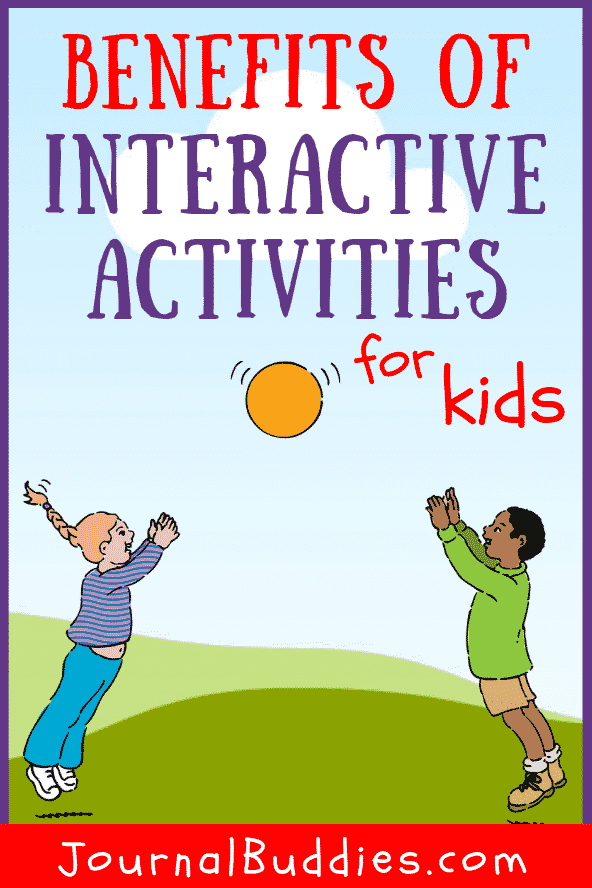Here you’ll discover interactive activities and why interactive learning is important for student learners— Conventional teaching methods like lectures and book reports are great educational tools, but they can also be a little dull and boring. This is especially true for younger students. Spice up your classroom or home learning environment by working to make learning more interactive! Let’s explore more about Interactive Activities now…

Why Interactive Learning is Important
Our best answer to tis question is that interactive activities are fun for kids and also provide numerous benefits for a child’s physical well-being, learning, and social and behavioral skills. By making playtime educational, kids can learn important lessons while still having a great time. Interactive learning also provides space for kids to bond with those around them and can encourage a lifelong interest in learning by making the experience enjoyable and engaging.
After this list of writing prompts about interactive activities (shown below), you will learn more about four different types of interactive activities—as well as the benefits each category offers you and your kids.
But for now… get to it and check out the following journal prompts. We suggest you either work together to draft a mutual opinion or write your own responses and then discuss your answers together. Now that’s a great idea for making writing interactive, so get to it.
Interactive Activities Writing Prompts
- Find a picture online. Then, imagine what is going on in the image or what the people in it are thinking. Be as specific as possible.
- Write a shared history that details the story of your relationship with one another. What special memories do you have?
- Close your eyes and be quiet for three minutes. Then, write about all the interesting things you noticed about your environment or your body during the three minutes of quiet time.
- Give the other person a writing assignment of your own—then share your work and see what the other person came up with!

- What would your dream house be like? Describe the types of rooms it would have and what special features it would include.
- Describe three notable things that have happened in the world in the last year—then discuss the events you chose and how you responded to them.
- Rewrite your own ending to a popular fairy tale or children’s story.
- Listen to a song and then write about how it made you feel. Did the music evoke any particular emotions? Did the words remind you of anything?
- Find a news story online about something currently going on in the world. Discuss your opinions on the subject.
Four Types of Interactive Activities for Kids (and the Benefits of Each One!)
Here we explore more about why interactive activities and why interactive learning is important. You see…
Interactive activities are a fun way for kids to play and learn, whether they’re interacting with friends, teachers, or parents. Use the following activity categories to create some hands-on learning opportunities for your kids.
1. Physical Activities Promote Fitness and Health
Kids today tend to play outside less than their parents and grandparents did, so it’s important to make sure your kids are getting enough exercise and learning to use their bodies. That’s why physical learning activities are such a great idea!
Going outside to play is a fun way to break up a boring day of classroom work, and kids who participate in physical activities tend to have healthier bodies. Best of all, physical games don’t just get kids moving—they can also help students develop important attributes like agility, strength, balance, and flexibility.
Here are a few fun physical activities to promote full-body learning:
- Hide and Go Seek is a classic that encourages both movement and strategic thinking!
- Simon Says or Follow the Leader are both effective, active games to play with kids of any age. These games involve plenty of movement—but kids will also need to be quick on their feet and pay close attention!
- Set up an obstacle course outside and time kids to see how quickly they can move through all the challenges!
2. Games and Puzzles Aid in Skill Development
If you want to teach skills like logic, creativity, or imaginative thinking, games, and puzzles are fantastic tool. Stimulating, interactive games can be used to teach basic skills like math, reading, and writing—or they can be used to teach soft skills like critical thinking, organization, and teamwork.
There’s no shortage of educational games and puzzles to play with kids of all ages, but here are a few of our favorites:
- Scavenger hunts are a fun way to problem-solve on the go, particularly when they involve clues or puzzles that must be figured out in order to move on!
- Build a fort out of household items and work together to figure out the answers to questions like: What items will work the best as walls? Is it possible to give your fort windows? How big does the fort need to be to hold everyone?
- Charades or games like Pictionary are a fun way to get everyone involved in puzzle-solving together!
3. Collaborative Activities Improve Social Skills and Tighten Bonds
Interactive activities also offer plenty of opportunities for kids to improve their social skills and to bond with those around them, particularly when the activities focus on collaborating or working together to achieve a goal.
Try the following activities to promote important skills like cooperation, communication, and teamwork:
- Collaborative storytelling is a fun way to get two or more people to work together to achieve a shared goal. Give each person a list of words or set of images and take turns writing sentences using your designated words or pictures. Each person gets to contribute—but you’ll have to work together to create a cohesive story in the end!
- Journal together and share your thoughts to learn more about what others think and to promote positive, healthy discussion!
4. Cooperative Games Teach Essential Life Lessons
Finally, cooperative games are also a great way to help kids learn important life lessons like how to be a good sport, how to follow rules, and how to communicate and work together toward a shared goal. Games and group activities with established rules and guidelines can also help kids develop their self-control skills, as they have to learn to control their impulses to succeed.
To promote skills like cooperation and sportsmanship, try interactive group activities like:
- Team sports such as soccer and basketball quickly help kids learn that each player has a role—and that everyone must work together if you want a chance to win!
- Board games can be played with each person competing on their own or in teams—but no matter what, everyone must play by the rules and follow directions for things to be fair!
- Paint a mural or do another large-scale craft that requires a lot of hands (and a lot of joint decision-making and cooperation!) to come out successfully.
To learn more about interactive activities for kids, check out these additional resources:
- Interactive learning and reading activities
- Online educational games for kids
- Interactive learning resource site for teachers
- More physical interactive games for children
- Fitness-oriented games, activities, and contests for kids
Until next time, write and play on!
If you enjoyed these Interactive Activities and our exploration of Why Interactive Learning is Important, please share them on Facebook, Twitter, and/or Pinterest.
I appreciate it!
Sincerely,
Jill
journalbuddies.com
creator and curator






